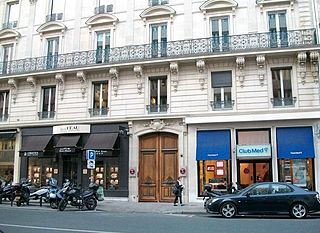Related Research Articles

Surrealism is a cultural movement that developed in Europe in the aftermath of World War I in which artists depicted unnerving, illogical scenes and developed techniques to allow the unconscious mind to express itself. Its aim was, according to leader André Breton, to "resolve the previously contradictory conditions of dream and reality into an absolute reality, a super-reality", or surreality. It produced works of painting, writing, theatre, filmmaking, photography, and other media.

Salvador Domingo Felipe Jacinto Dalí i Domènech, Marquess of Dalí of Púbol, known as Salvador Dalí, was a Spanish surrealist artist renowned for his technical skill, precise draftsmanship, and the striking and bizarre images in his work.

André Robert Breton was a French writer and poet, the co-founder, leader, and principal theorist of surrealism. His writings include the first Surrealist Manifesto of 1924, in which he defined surrealism as "pure psychic automatism".

Paul Éluard, born Eugène Émile Paul Grindel, was a French poet and one of the founders of the Surrealist movement.

Gala Dalí, usually known simply as Gala, was the wife of poet Paul Éluard and later of artist Salvador Dalí, who were both prominent in surrealism. She also inspired many other writers and artists.

David Gascoyne was an English poet associated with the Surrealist movement, in particular the British Surrealist Group. Additionally he translated work by French surrealist poets.
Four Surrealist Manifestos are known to exist. The first two manifestos, published in October 1924, were written by Yvan Goll and André Breton, the leaders of rival Surrealist groups. Breton published his second manifesto for the Surrealists in 1929, and wrote his third manifesto that was not issued during his lifetime.
The paranoiac-critical method is a surrealist technique developed by Salvador Dalí in the early 1930s. He employed it in the production of paintings and other artworks, especially those that involved optical illusions and other multiple images. The technique consists of the artist invoking a paranoid state. The result is a deconstruction of the psychological concept of identity, such that subjectivity becomes the primary aspect of the artwork.

Óscar M. Domínguez was a Spanish surrealist painter.

Valentine Hugo (1887–1968) was a French artist and writer. She was born Valentine Marie Augustine Gross, only daughter to Auguste Gross and Zélie Démelin, in Boulogne-sur-Mer. She is best known for her work with the Russian ballet and with the French Surrealists. Hugo died in Paris.

Minotaure was a Surrealist-oriented magazine founded by Albert Skira and E. Tériade in Paris and published between 1933 and 1939. Minotaure published on the plastic arts, poetry, and literature, avant garde, as well as articles on esoteric and unusual aspects of literary and art history. Also included were psychoanalytical studies and artistic aspects of anthropology and ethnography. It was a lavish and extravagant magazine by the standards of the 1930s, profusely illustrated with high quality reproductions of art, often in color.

The Death of Salvador Dalí is a 2005 American fantasy short film written and directed by Delaney Bishop. The plot concerns Salvador Dalí consulting Sigmund Freud on how to depict madness in his artwork.

Jacqueline Lamba was a French painter and surrealist artist. She was married to the surrealist André Breton.
Richard Oelze was a German painter. He is classified as a surrealist.
Le Surréalisme au service de la révolution was a periodical issued by the Surrealist Group in Paris between 1930 and 1933. It was the successor of La Révolution surréaliste and preceded the primarily surrealist publication Minotaure.

Women Surrealists are women artists, photographers, filmmakers and authors connected with the surrealist movement, which began in the early 1920s.

The Exposition Internationale du Surréalisme was an exhibition by surrealist artists that took place from January 17 to February 24, 1938, in the generously equipped Galérie Beaux-Arts, run by Georges Wildenstein, at 140, Rue du Faubourg Saint-Honoré in Paris. It was organised by the French writer André Breton, the surrealists' brain and theorist, and Paul Éluard, the best known poet of the movement. The catalogue listed, along with the above, Marcel Duchamp as generator and arbitrator, Salvador Dalí and Max Ernst as technical advisers, Man Ray as head lighting technician and Wolfgang Paalen as responsible for the design of the entrance and main hall with "water and foliage". The exhibition was staged in three sections, showing paintings and objects as well as unusually decorated rooms and mannequins which had been redesigned in various ways. With this holistic presentation of surrealist art work the movement wrote exhibition history.

Nadrealizam danas i ovde was the official magazine of the Serbian surrealists from the 1930s. It was known as NDIO for short.
Sheila Legge was a Surrealist performance artist. Legge is best known for her 1936 Trafalgar Square performance for the opening of London International Surrealist Exhibition, posing in a costume inspired by a Salvador Dalí painting, with her head completely obscured by a flower arrangement.
References
- ↑ "Composition - Leeds Art Fund". www.leedsartfund.org. Archived from the original on 19 August 2017.
- ↑ http://prentwerkartbooks.blogspot.co.uk/ [ user-generated source ]
- ↑ Hessellund, Birgit (1995). "Rita Kernn-Larsen (1904 - 1998)" (in Danish). KVINFO . Retrieved 24 November 2017.
- 1 2 Penelope Rosemont (2000). Surrealist Women, An International Anthology. Texas: The University of Texas Press. pp. 88–90. ISBN 9780567171283 . Retrieved 19 February 2017.
- ↑ "Dylan Thomas". dylan.llgc.org.uk. Archived from the original on 19 August 2017. Retrieved 18 August 2017.
- ↑ International Surrealist Exhibition (PDF). Women's Printing Society, Ltd. 1936. OCLC 9735630 . Retrieved 27 September 2022– via Monoskop.
- ↑ Crawford, Elizabeth (20 October 2020). "The Women's Printing Society". The British Library. Retrieved 27 September 2022.